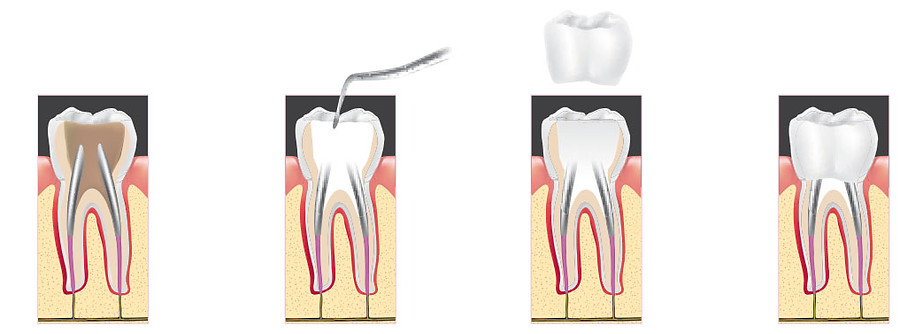Root Canals

Root canal treatment is a dental procedure that alleviates pain caused by an infected or abscessed tooth. It involves the removal of inflamed pulp, thorough cleaning and disinfection of the tooth's interior surfaces, and the placement of a filling to seal the space.
This treatment is required when the pulp inside your tooth becomes inflamed or infected due to factors such as deep decay, repeated dental procedures, faulty crowns, or a crack/chip in the tooth. Even if there are no visible chips or cracks, trauma to the tooth can also cause damage to the pulp. Neglecting to treat pulp inflammation or infection can result in pain and may lead to the formation of an abscess.
As a general rule, all root filled teeth should be restored with a crown or a restoration covering the whole tooth. This may or may not require a post.
Procedure of Root canal

1
2
3
4
Infected tooth
Decay is removed, and access gained in the tooth
Files cleaning root canal and the infected pulp is removed
Root canals are cleaned and shaped

5
The canals are filled to prevent re-infection
6
Temporary filling or Preliminary Restoration For Crown
7
Inserting crown
8
Completed treatment
Signs that you may require root canal therapy include:
-
Persistent tooth pain: If you have deep-seated tooth pain that persists, it could indicate the need for a root canal. Discomfort may also radiate to your jaw, face, or adjacent teeth.
-
Sensitivity to heat and cold: If your tooth hurts when you consume hot beverages or cold foods like ice cream, it may be an indication that you require root canal treatment. Particularly if the pain lasts longer than a few seconds.
-
Swollen gums: Infection in a tooth can lead to the accumulation of pus in the area, causing swollen, puffy, or tender gums.
-
Pimple on the gums: The presence of a pimple or boil on the gums can be a sign of an infected tooth. Pus from the infected tooth may drain from the pimple, resulting in an unpleasant taste or odour.
-
Swollen jaw: When pus is unable to drain from the infection site, the jaw may visibly swell.
-
Tooth discoloration: Infection in the tooth's pulp can cause the affected tooth to appear darker due to inadequate blood supply.
-
Pain upon applying pressure: If you experience pain when you eat or touch the affected tooth, it may indicate nerve damage around the pulp.
-
Chipped or cracked tooth: Bacteria can penetrate the tooth pulp when a tooth is cracked or chipped due to accidents, sports injuries, or biting down on hard objects.
-
Loose tooth: An infected tooth may feel loose as the pus from the infected pulp can weaken the supporting bone.
Undergoing endodontic treatment enables you to preserve your natural smile, enjoy your favourite foods, and reduces the necessity for further dental procedures. With appropriate care, most teeth that have undergone root canal treatment can last a lifetime.


